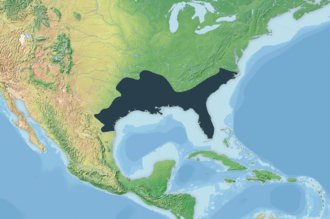On this post, I will list a group of articles on North American politics and stories. It is unfortunately a fact, that, no matter what your position is on American...

American Alligator

The American Alligator is found throughout Florida and the South east of the USA. It is considered low risk/ least concern by IUCN and Appendix ii on CITES (allows trade, but keeps track of status so that trade can be restricted or curtailed if the wild population becomes threatened). They generally grow to 3.4-4.6m in length.
In the past, overhunting was a problem and the species was threatened with extinction. In 1967, it was listed as endangered, as it was considered at risk of extinction in part of its range. Both the United states fish and wildlife service and wildlife services in the area, helped to save the species, and in 1987 it was removed from the endangered species list. It is listed under CITES appendix ii, so trade is allowed but carefully monitored and controlled. They are more capable of surviving in cold water than the American crocodile, being able to survive in 7 degree water for some time.
Indeed, in the northern part of their range, they are capable of surviving in water that is freezing at the surface. They put their nose out of the water, so they can breathe and enter a mode called Brumation, and they can then remain still for at least several days. In places like the everglades, they change their habitat, creating so called Alligator ponds, and are therefore considered keystone species.
They have been regularly spotted using lures to tempt in birds, showing simple tool use, making them among the first reptiles to be noted doing so. They put suitable nesting materials on their head, and then grab the bird when it comes to access the materials on offer. They have been seen eating sharks and rays; four incidents documented indicated that bonnetheads, lemon sharks, Atlantic stingrays, and nurse sharks are components of the animal’s diet. This is not a one way street, with sharks also predating alligators. Generally as young, they feed on various species found in water, with the prey size increasing as they do. Adults can take boar and deer on occasions. They have even (while rare) been seen to predate and eat bobcats. Oddly, they are not pure carnivores, having been noted to eat fruits and other vegetation from as many as 46 genera being consumed. They have also been seen cooperatively hunting – suggesting a reasonable level of intelligence.
They are the most vocal of non-avian reptiles, making a variety of noises. They have regularly been seen to live to 50, with an estimated possible lifespan of around 70 years. Males reach sexual maturity at around 11.6 with females getting their at 15.8. Males appear to stop growing at around age 43 while females do so at 31 (originally it was thought that they never stopped growing.
20-50 eggs are laid (around the size of a goose egg. They are covered in vegetation, which helps warm the eggs while it decays. Sex is decided based on temperature, resulting in location of the nest being important as to the balance of sex. The mother stays close by to protect her nest, and to help dig them out when they hatch. Once hatched she will carry them to water and then guard them until they have grown a certain amount. At that point she becomes aggressive to them, causing them to head off on their own and the whole process starts again. Two invasive species are found in their habitat Nutra (coypu) and Burmese pythons. While these species have both become well established, it appears that the American Alligator is essential to stop them expanding their range or increasing in number. While rare, attacks on humans do occur, although this is almost always found to be mistaken identity. There have been 257 documented attacks on humans in the last 50 years, or about 5 a year, and only 23 resulted in death, so this is a relatively low proportion.
Alligator wrestling does occur as a sport, and was started by tribes, before Europeans arrived. This remains popular, despite animal rights protests.
They are farmed in Georgia, Florida, Louisiana and Texas for their hide, with around 45,000 hides harvested a year. A hide sells for around $300.
Their wild population is thought to number around 5 million.
Below, is a video of this species, and below that is a list of any mentions it has had on this website (if any, as yet). Below this, we will add any links to places where this species can be seen in the wild.